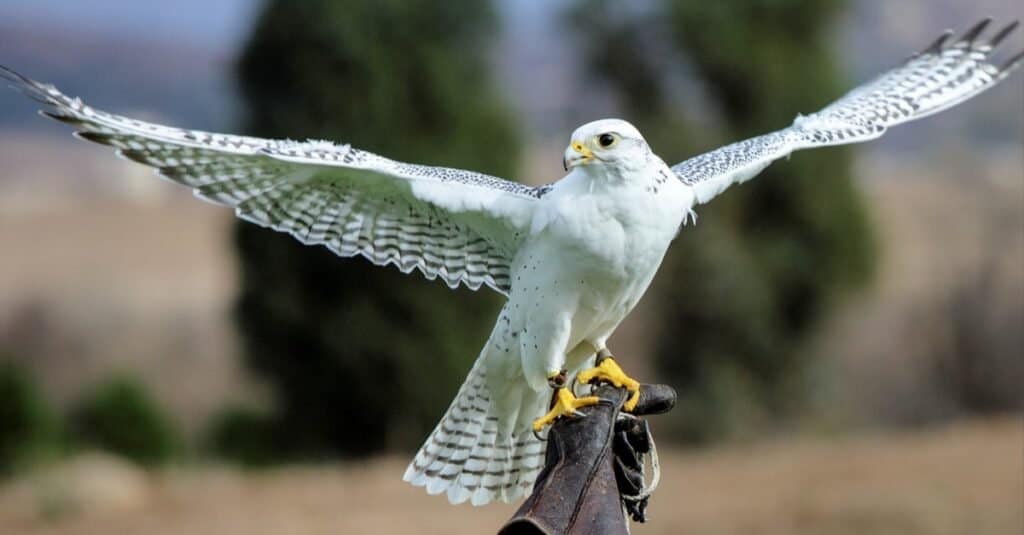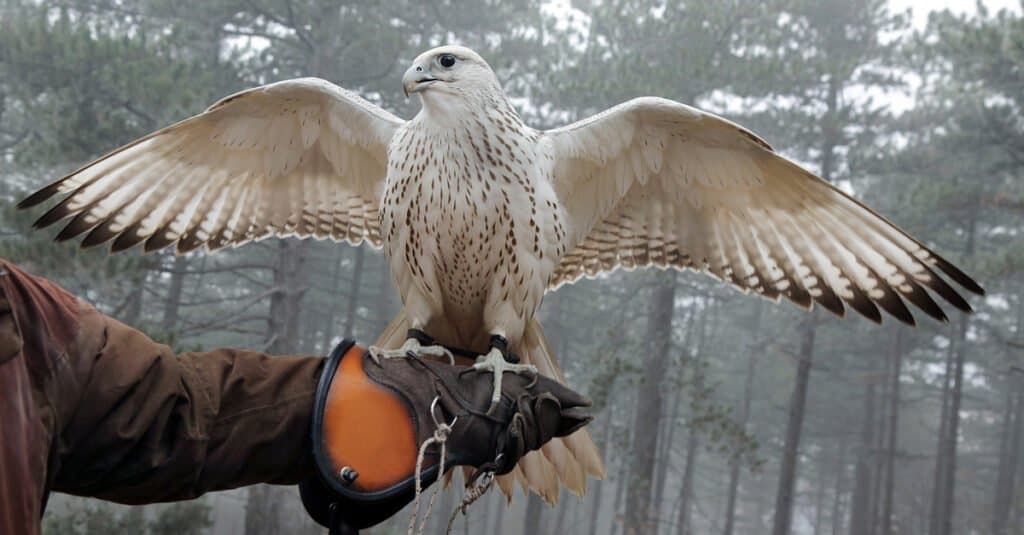When thinking of birds of prey, the first thing that might come to your mind is a falcon. Falcons are one of the most well-known birds of prey and are designed to kill. Sharp beaks, long claws, and keen eyesight make them one of the most effective hunters. Falcons travel everywhere and are a migrating species. Some species migrate more than 20,000 miles yearly and have great homing instincts to accurately navigate the skies.
Falcons are some of the fastest birds alive, and one species can even travel up to 240mph. They belong to the family of Falconidae, which also contains caracaras. In the Falconidae family, there are around 60 species. Hawks are also common birds of prey but tend to be larger larger than falcons among other differences. Falcons are medium-sized birds, but each species differs. In this article, you will discover the size of the largest falcon and other exciting things to know about different species.
The Largest Falcon in the World

Gyrfalcons can have a wingspan that exceeds 5 feet in length.
©John Hancock/Shutterstock.com
The largest falcon in the world is the Gyrfalcon.
Female gyrfalcons are usually 20 to 25.5 inches long, with a 49 to 63-inch wingspan. Males reach around 19 to 24 inches long and have a wingspan between 43 to 51 inches. Females, on average, are heavier and larger. The weight of the average gyrfalcon is around 3.2lbs, and most will fall between 2.1 to 4.4 lbs.
One of the largest gyfalcones every recorded was a female found was in Siberia that weighed 5.12 lbs.
What Is The Gyrfalcon

Despite their large size, gyrfalcons can dive at 130 miles per hour.
©Selena_ Q/Shutterstock.com
Gyrfalcons are found around Alaska, Scandinavia, Greenland, Iceland, and Canada. They prefer open habitats and live mostly in cold areas. Cliffsides, mountains, and coastal areas are common places they live. Unlike other falcon species, the gyrfalcon does not migrate often but will do so when food is scarce. They breed in arctic tundras and can bathe in icy waters.
Like other falcons, this species is carnivorous and feeds on small animals like rabbits and sea birds. Predators threaten only young specimens. The gyrfalcon is ferocious and flies at high altitudes to scan for prey when fully grown. Flying so high, they can avoid most predators and are only threatened by bald eagle species. Even being so large, they are still one of the fastest bird species globally. They have a top airspeed of 130 mph and a quick horizontal speed of 50 to 68 mph.
Gray, white, and black the colors of this species. Other color morphs like brown and all-white also exist. Short sharp beaks, large eyes, and piercing talons are traits it shares with other falcon species. Their eyes are dark, and their wings have a pointed look. Gyrfalcons in the wild only live for around 13 years but can live for 19 years in captivity.
Different Types Of Falcon Species
The Genus of Falco has around 40 different species. The gyrfalcon is the largest, and the smallest species is the kestrel falcon.
One of the most interesting falcons is the Peregrine falcon, the fastest flying bird in the world. It can reach up to 242 mph when diving for prey and is one of the fastest animals ever recorded. Gray falcons are the rarest species and are listed as vulnerable.
Here are some falcon species and their size to compare them with the largest of them all, the Gyrfalcon.
Peregrine Falcon
Weight: 0.7 to 3.3lbs
Wingspan: 28.8 to 46.8 in
Body Length: 13 to 23 in
Saker Falcon
Weight: 2.1lbs
Wingspan: 47 to 51 in
Body Length: 17.7 to 21 in
Gray Falcon
Weight: 0.6 to 1.3 lbs
Wingspan: 33 to 37.4 in
Body Length: 11.8 to 17.7 in
Kestrel Falcon
Weight: 0.3 to 0.4 lbs
Wingspan: 27 to 33 in
Body Length: 11 to 15 in
Red-Necked Falcon
Weight: 0.3 to to 0.6 lbs
Wingspan: 33.4 in
Body Length: 11.8 to 14.7 in
Prairie Falcon
Weight: 1.1 to 2.1 lbs
Wingspan: 42 in
Body Length: 15 to 17.7 in
Falcons Compared With The Largest Bird Species
Falcons are medium-sized birds, and there are much larger species of birds flying in the sky. The ostrich is the largest bird species but is unable to fly. Ostriches can weigh up to 330lbs and can grow 9 feet tall. The largest flying bird is the Wandering Albatross. They have a wingspan of 12.1 feet and weigh around 16 lbs. In birds of prey species, the largest of all is the endangered Andean Condor. Andean condors have a wingspan of approximately 10 feet and weigh a maximum of 33lbs. Condors, eagles, vultures, and owls are all some of the largest birds of prey species.
Hawks are similar in size and are also another bird of prey species. The largest hawk species, the Ferruginous hawk, is similar in size to the largest falcon. Usually, hawks are larger than falcons, but they vary depending on the species. Hawks and falcons are similar species but have differences that can help you tell them apart.
What Are The Biggest Threat To Falcons
The gray falcon is the rarest species and is listed as a vulnerable species. Other falcon species like the peregrine falcon have been considered endangered but brought back with conservation efforts. Falcons in most areas are protected to help preserve their population.
Climate change, disease, and loss of habitats are the biggest threat to falcons. A danger that all bird species face is human inventions, like planes and wind turbines. It is estimated that around 500,000 birds die each year from wind turbines, including important species like hawks, eagles, owls, and falcons. Steps are being taken to help preserve falcons and other bird species at risk.
The photo featured at the top of this post is © Selena_ Q/Shutterstock.com
Thank you for reading! Have some feedback for us? Contact the AZ Animals editorial team.







